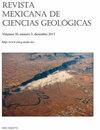Weathering and biodegradation of hydrothermal petroleum in the north rift of Guaymas Basin, Gulf of California
IF 0.5
4区 地球科学
Q4 GEOSCIENCES, MULTIDISCIPLINARY
Revista Mexicana De Ciencias Geologicas
Pub Date : 2019-07-28
DOI:10.22201/CGEO.20072902E.2019.2.1054
引用次数: 2
Abstract
The Guaymas Basin, Gulf of California, is an actively spreading ocean basin, part of the system of spreading axes and transform faults extending from the East Pacific Rise to the San Andreas fault. Upward migration of hydrothermal petroleum in the basin rifts occurs by both bulk transport and high temperature/pressure aqueous and supercritical gaseous (e.g. CO2, CH4) fluid phases into the seabed sediments. The resulting mounds are laden with the youngest hydrothermal petroleum known to date. The north rift hydrothermal system has been dormant for ~ 3000 years, and organic geochemical analyses of sediment samples collected by both piston and push corers and by dredging operations from various cruises to the Gulf of California show that the organic matter is composed primarily of autochthonous lipids from marine biota, overprinted by hydrothermal petroleum. The chemical composition of this petroleum indicates severe biodegradation for exposed samples, based on the contents of aliphatic, aromatic, steroid, and hopanoid biomarkers. Sulfurized lipids are enriched in the biodegraded oils. Both hydrothermal minerals and petroleum in the mounds of the north rift seabed have been weathered by oxidative/microbial processes.加利福尼亚湾Guaymas盆地北部裂谷热液石油的风化和生物降解
加利福尼亚湾瓜伊马斯盆地是一个活跃扩张的海洋盆地,属于从东太平洋隆起向圣安德烈亚斯断层延伸的扩展轴和转换断层系统的一部分。盆地裂谷中的热液油气以大宗运移和高温/高压水相和超临界气相(如CO2、CH4)向海底沉积物运移的方式向上运移。由此产生的土丘中充满了迄今为止已知的最年轻的热液石油。北裂谷热液系统已休眠约3000年,通过对活塞盖和推覆盖所采集的沉积物样本以及多次前往加利福尼亚湾的游轮疏浚作业进行的有机地球化学分析表明,其有机质主要由来自海洋生物群的天然脂质组成,并被热液石油覆盖。根据脂肪族、芳香族、类固醇和藿烷类生物标志物的含量,这种石油的化学成分表明,暴露的样品存在严重的生物降解。硫化脂在生物降解油中富集。北裂谷海底土丘中的热液矿物和石油均受到氧化/微生物作用的风化。
本文章由计算机程序翻译,如有差异,请以英文原文为准。
求助全文
约1分钟内获得全文
求助全文
来源期刊

Revista Mexicana De Ciencias Geologicas
地学-地球科学综合
CiteScore
1.00
自引率
12.50%
发文量
0
审稿时长
6-12 weeks
期刊介绍:
Revista Mexicana de Ciencias Geológicas (RMCG) publishes original research papers on geological processes of broad interest, and particularly those dealing with regions of Latin America. The RMCG also publishes review papers on topics of current interest, and on the geology and tectonics of geological provinces of Latin America. Besides, it offers the opportunity for host editors to publish special thematic issues.
 求助内容:
求助内容: 应助结果提醒方式:
应助结果提醒方式:


